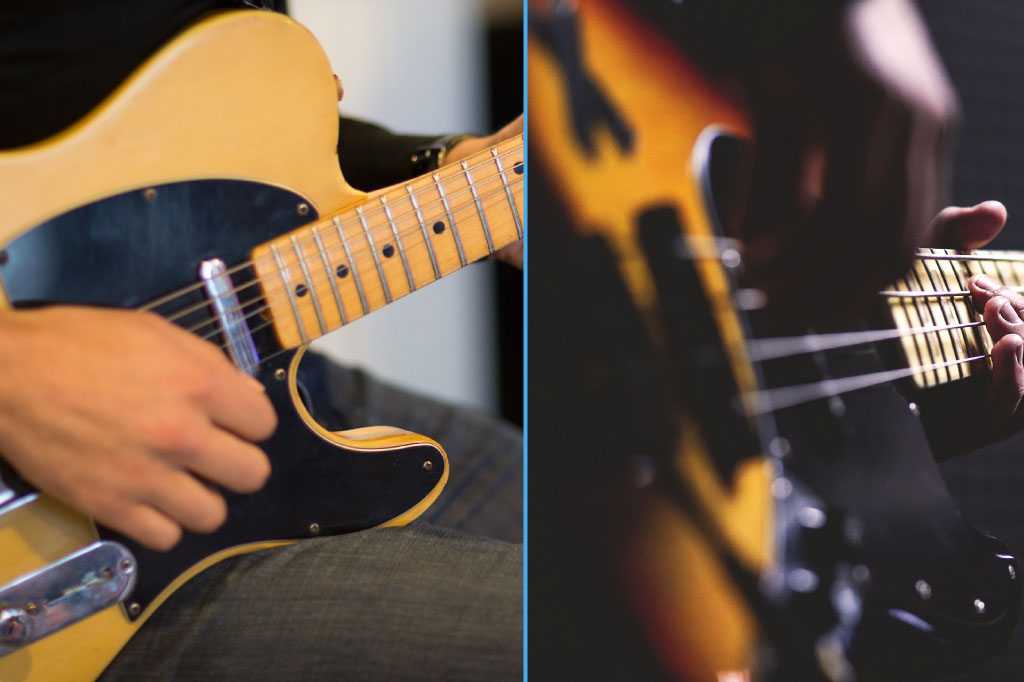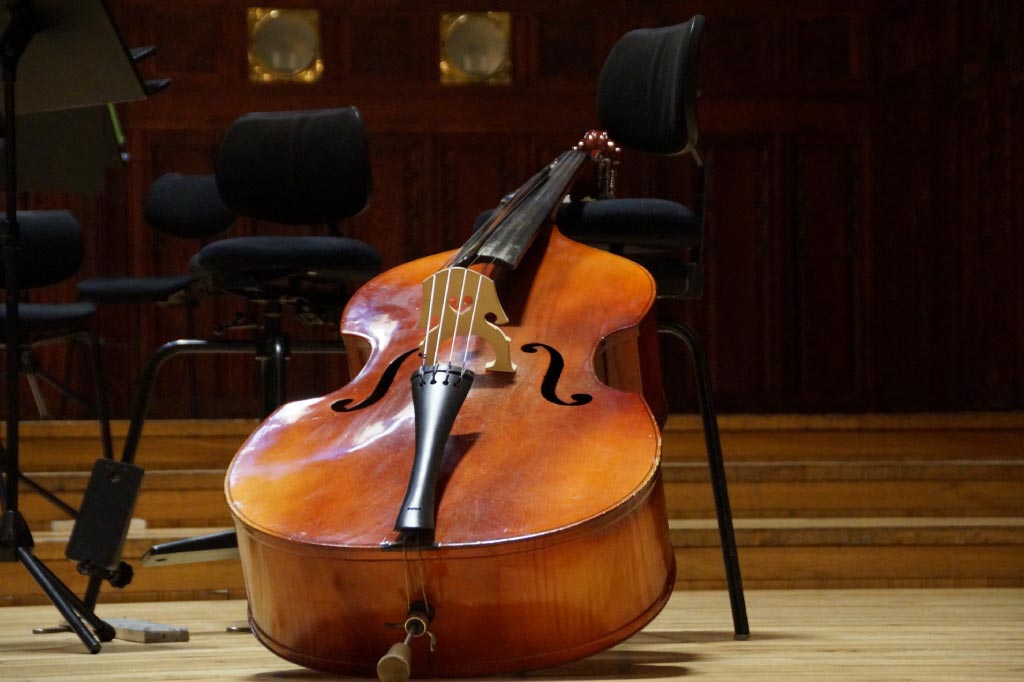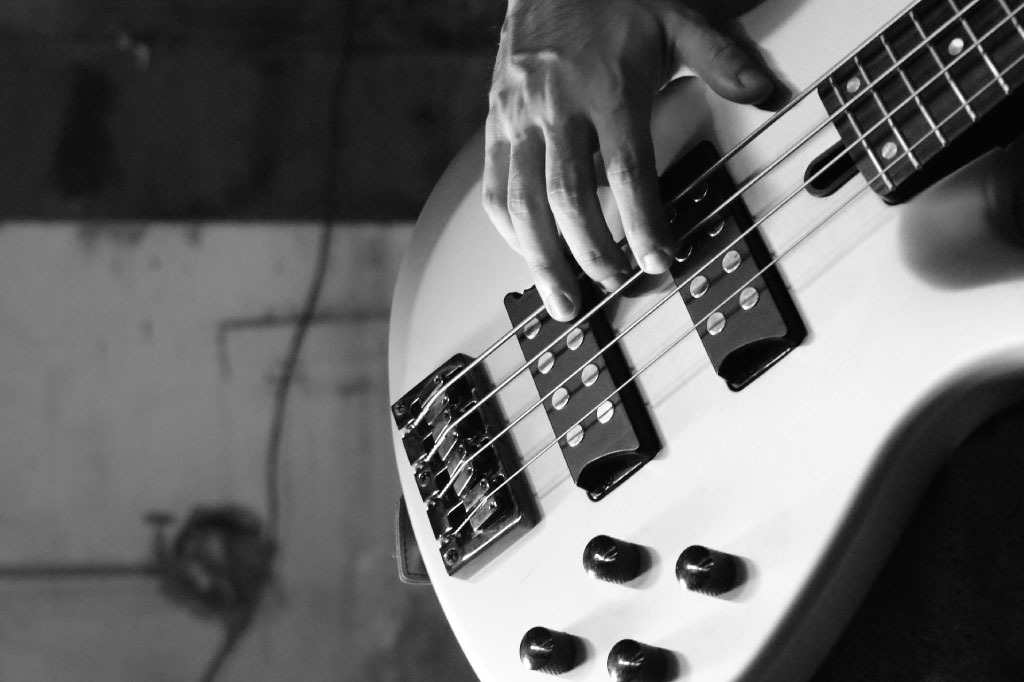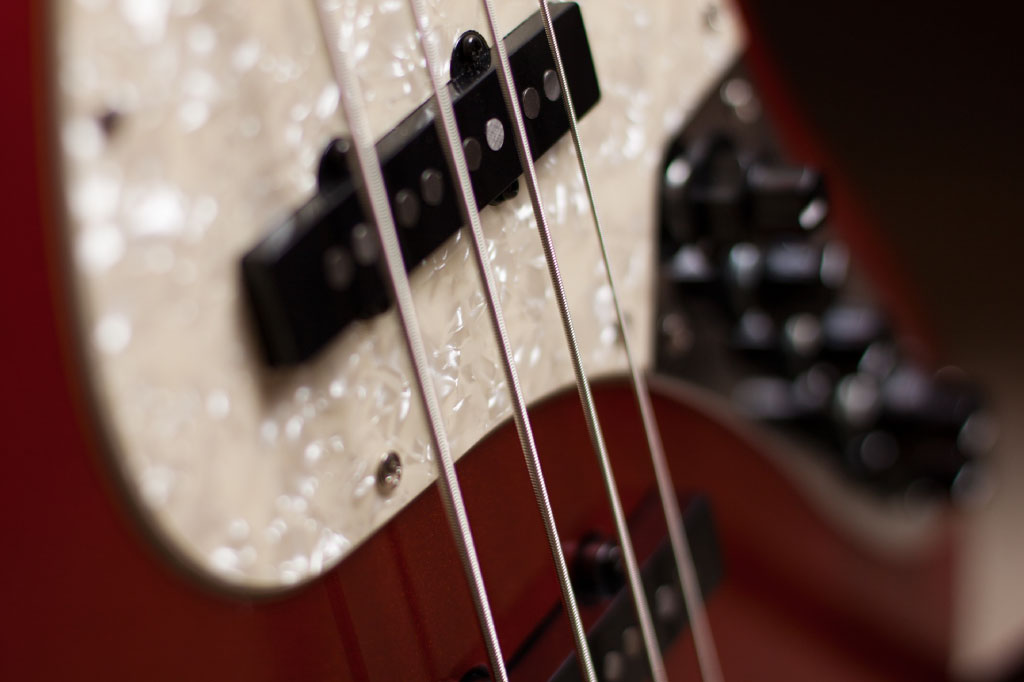On this page we attempt to give a definitive answer to the commonly-asked question ‘is a bass a guitar?’ We’ll assume that the question is referring to a bass guitar, rather than to an upright bass.
Page Index
- Introduction
- Bass Vs Guitar
- A Deeper Look
- History Of The Bass Guitar
- The First Bass Guitar
- History Of The Guitar
- Similarities Between A Bass And A Guitar
- Differences Between A Bass And A Guitar
- Is A Bassist A Guitarist?
- Is A Bass A Guitar? Conclusion
Introduction
At first glance, the electric bass could easily be considered to be a four string variant of the electric guitar; both instruments look much the same, and work in the same way.
However, there are fundamental differences between the two instruments which, in this article, we’ll take a closer look at.
Bass Vs Guitar

Differences between a bass and a guitar
- A typical bass guitar has 4 strings; a guitar has 6.
- A bass is tuned an octave lower than a guitar.
- The neck of a bass is longer than that of a guitar.
- The frets on a bass guitar are wider than those on a guitar.
- Bass strings are wider (i.e. have a larger diameter) than guitar strings. (Bass strings can’t be used on a guitar, and vice versa.)
- Bassists generally play single note lines and don’t usually play chords. (Guitars often play both single note lines and chords in the same song.)
- The bass is rarely played as a solo instrument. Although the same can be said of an electric guitar, other types of guitar are commonly played without accompaniment.
- Although a bass can be played through a guitar amp, doing so may damage the amp (especially the speaker), as guitar amps aren't designed to handle bass frequencies.
- The bass is the electric version of a double bass. Guitars stem from another family of instruments.
Similarities between bass and guitar
- Bass strings are tuned to the same pitch as the lowest 4 strings on a guitar, only an octave lower.
- The notes on a bass are the same as those on the lowest 4 strings of a guitar, only an octave lower.
- Bass pickups and guitar pickups work in the same way.
- Basses and guitars use the same type of lead.
- Playing with a pick involves a similar technique on both instruments.
Quick Conclusion
It could be argued that a bass is a type of guitar, after all it’s even called a ‘bass guitar’. However, given the number of differences between a bass and a guitar, the bass should be considered to be an instrument in its own right, rather than a type of guitar.
Need more convincing? Read on...
A Deeper Look...
Although outwardly a bass guitar is similar to an electric guitar, its origins lie in a different family of instruments.
Whereas the bass is an electric version of the double bass – a member of the bowed violin family, the guitar’s ancestors are plucked instruments such as the lute and vihuela.
There are also significant physical differences between a bass and a guitar. The most apparent of these is that a typical bass has four strings compared to a guitar’s six. The bass is also designed to be tuned an octave lower, and has a correspondingly longer neck and wider frets.
Although there is some overlap in the technique used to play the bass and the guitar, each instrument has its own range of techniques and playing styles.
In addition, the two instruments traditionally play different roles within a band.
A bassist is usually seen as a member of a band’s rhythm section. Although a bass can be used to play riffs and solos, its primary function is to provide a rhythmic (and tonal) foundation to the band’s overall sound.
A guitar too can be used to provide rhythmic support, but is also far more likely than a bass to be used to play riffs and other melodic lines.
Another fundamental difference is that a bass is typically used to play single-note lines, whereas a guitar is also used to play chords. (Although, of course, chords can, and are, played on the bass. See this page: Bass Chords.)
Knowing this, it would be hard to argue that a bass is a guitar. Let’s take a deeper dive into the history of the two instruments…
History Of The Bass Guitar

The bass guitar is descended from the upright double bass, rather than from the various plucked instruments that gave rise to the guitar.
An upright bass is clearly not a guitar; it is constructed in a similar manner to instruments in the violin family, and it is with this group of instruments that it shares its ancestry.
An upright bass is traditionally played with a bow. Although it can be plucked (indeed, this is the technique used by most upright jazz bassists), it is known as a bowed instrument.
Instruments in the violin family are descended from bowed instruments from the renaissance period such as the lira da braccio, which themselves may have descended from medieval instruments such as the Byzantine lyra.
A depiction of a Byzantine lyra being played (with a bow) on an ivory casket has been dated to between 900 and 1100 AD.
The First Bass Guitar
The first bass guitar was invented by American musician and inventor Paul Tutmarc (See Wikipedia). The new instrument was released in 1936, and marketed as the 'Audiovox Model 736 Bass Fiddle'.
Tutmarc’s bass fiddle appeared a few years after the earliest electric guitars, and was based on similar technology, having a solid body and using magnetic pickups to convert the strings’ vibrations into an electrical signal.

Unlike the upright bass on which it was based, Tutmarc’s instrument was fretted, and designed to be played horizontally.
History Of The Guitar
The guitar’s ancestors include instruments such as the lute and the oud, both of which were plucked. The word ‘guitar’ is derived from the Spanish word guitarra, which itself comes from the Ancient Greek kithara – a word first used for harp-like plucked instruments.
Instruments known as guitarras were being played in Spain in 1200.
Plucked instruments known as ‘cytharas’ were in use in the 9th century. It may be instruments such as these that are the common ancestors of both the violin and the lute / guitar family of plucked instruments.
- See this page for more info: History of the Guitar
Similarities Between A Bass And A Guitar

Although the bass and the electric guitar have their origins in different instrument families, there are many similarities between the two instruments. It is these similarities which give rise to the question ‘is a bass a guitar?’
The two instruments are very similar in appearance. In their standard forms both have solid bodies with ‘horns’ that allow the player access to the higher frets. Both are strung with metal strings, and both rely on pickups to convert the strings’ vibration into an electrical signal.
Both a bass and a guitar are tuned in fourths. The bass guitar’s strings are tuned to the same pitches as the guitar’s bottom 4 strings, albeit an octave lower. As a result the notes produced at each fret are the same.
Perhaps most confusingly, the bass is played horizontally – just like a guitar. This belies its upright bass ancestry.
Both the electric bass and the electric guitar can be played with a pick, although many bassists play using just their fingers. Electric guitarists usually use a pick, but acoustic guitarists may also use their fingers.
Given the many similarities between the two instruments – especially in their respective appearances – it’s not surprising that those not ‘in the know’ consider a bass to be a guitar.
Differences Between A Bass And A Guitar

Once you have played a bass and a guitar the differences between the two instruments are much more apparent. The neck of the bass guitar is significantly longer, and the frets proportionally wider; even a major third interval is quite a stretch. Bass strings are much wider than even heavy-gauge guitar strings.
A bass neck feels huge after playing the guitar (likewise, an electric guitar seems very small and easy to play after a session on the bass!)
As we’ve already found, a bass’s role within a band is typically to provide a rhythmic and tonal foundation. The guitar, in addition to its rhythmic duties, is also employed for lead or melodic lines.
Is a Bassist a Guitarist?

A bass guitarist would rarely call himself a guitarist; he’d be much more likely to call himself a bassist, or a bass guitarist. A bassist wouldn’t answer an advert placed by a band looking to hire a guitarist (unless he also played the guitar).
Due to the similarities between the bass and the guitar, most bassists are able to turn their hands at playing guitar. However because the techniques involved are substantially different at anything beyond a basic level, many bassists stick to just the bass, and vice versa.
Is A Bass A Guitar? Conclusion
Although there are many similarities between a bass and a guitar, the instruments have their roots in different instrument families, are significantly different physically, and are typically used to play different roles within a band setting. Therefore, in our opinion, a bass should not be considered to be a guitar.
This answer is based on our personal experiences within the musical world; perhaps you feel differently. Do you think a bass is a guitar? Is it a type of guitar? Perhaps more importantly: why would anyone care? Let us know in the comments below!



The bass guitar is not an electric version of an upright – which is a very different instrument. It was made to be an easily transportable and amplifiable option in the form of an electric guitar. However, there were and still are amplified versions of the upright. Just like a bass clarinet or oboe or trombone is not a tuba. It may fill in but is not the same thing at all. Instead, it is a clarinet or oboe or trombone. How do you know? Look at it!